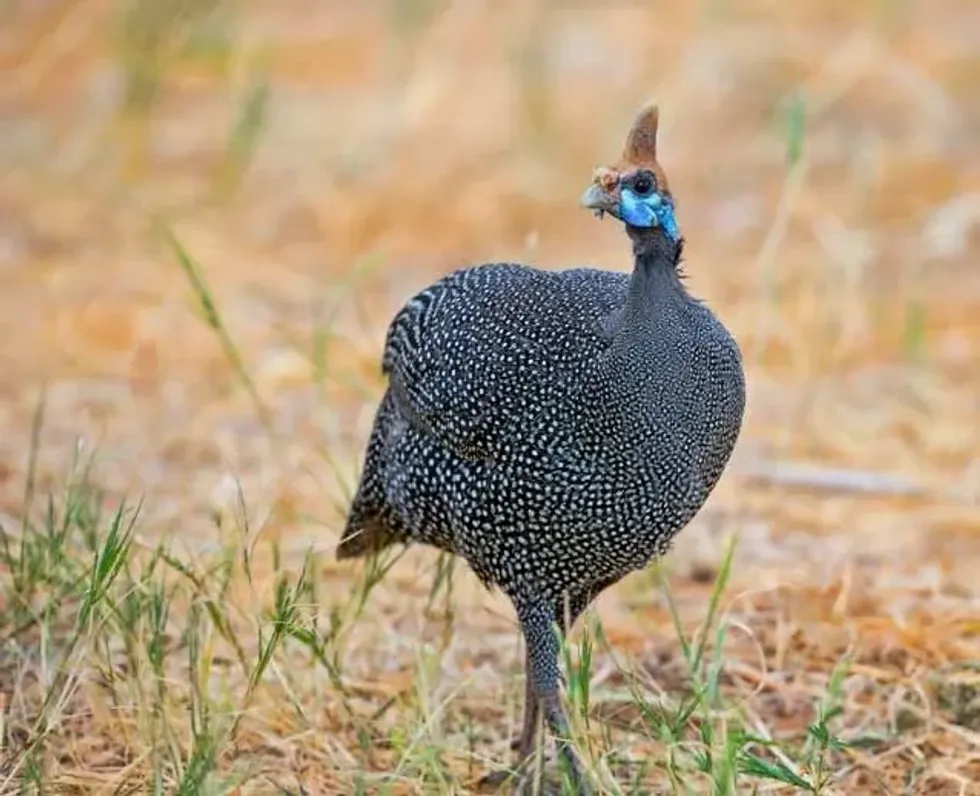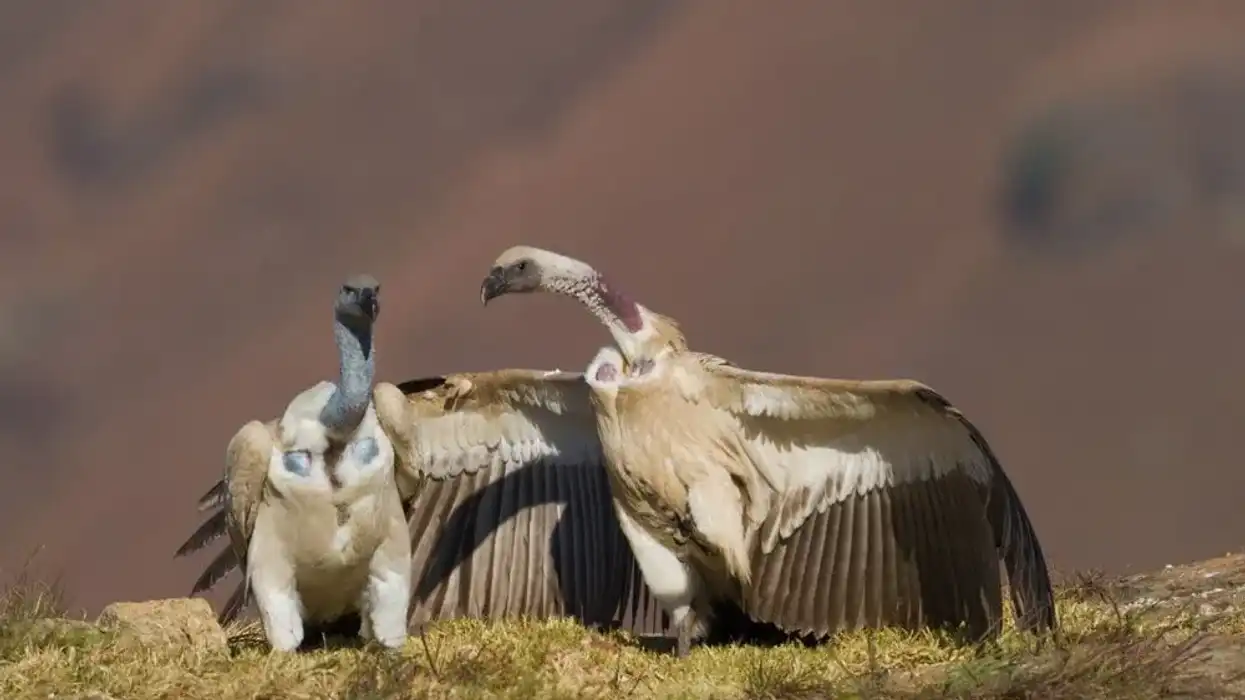The most recognizable feature of a helmeted guineafowl is its featherless casque sitting on top of the bird’s head. These birds are large in size with black-gray feathers spotted with white patterns.
The face and neck are blue. They look like large partridges with bald heads. Helmeted guinea fowls have well-developed wings.
They can fly like other birds but they prefer to walk and run rather than fly if they sense danger. They prefer to travel on foot and can walk up to a distance of 6 mi (9.6 km).
Tracing the origin of the helmeted guineafowl is not difficult at all once you know how the species got its scientific name. The guineafowl (Numida meleagris) gets its name from the word Numida which is the old Roman name for Africa and the term meleagris meaning guinea-fowl.
These birds of African origin are highly territorial. Males and females of every flock defend their territory.
If you like to read about birds, you may also look at our tawny eagle and wren facts pages!
Helmeted Guineafowl Interesting Facts
What type of animal is a helmeted guineafowl?
The helmeted guineafowl (Numida meleagris) is a native bird species of the African continent and has a wide range. This bird species was later domesticated and introduced to other continents. These birds belong to the order Galliformes family Numididae.
What class of animal does a helmeted guineafowl belong to?
The elmeted guineafowl (Numida meleagris) belongs to the class Aves meaning they are birds.
How many helmeted guineafowls are there in the world?
It is difficult to specify the exact population of helmeted guinea fowls due to their extensive range. Along with wild helmeted guinea fowls, a population of domesticated birds is also raised in various countries and kept in zoos. Their population is stable as they are reared as domestic birds.
Where does a helmeted guineafowl live?
Helmeted guineafowls are actually wild birds with a range covering several South African countries that have been domesticated in many countries. They are native to areas south of the Sahara and were mostly found in African countries like Angola, Burundi, Burkina Faso, Chad, however, they are not native to North American regions.
What is a helmeted guineafowl's habitat?
Helmeted guineafowls live in sub-Saharan semi-arid regions, scrublands, dry grasslands, agricultural lands, forests with scattered bushes and trees. These birds live in warm and dry tropical climates mostly in open habitats.
The wild, dry, semi-arid, topography with scattered trees and bushes is ideal habitat for these birds. Their favorite living grounds are a habitat that’s a mix of savannah and agricultural fields growing grains and seeds.
When in the wild, they live close to water sources, food, ground cover, and trees where they can roost. These species tend to roost on the branches of trees at night to be safe from predators.
Who does helmeted guineafowls live with?
Helmeted guineafowls are social birds and live in large groups of up to 40 birds or more. The flocks are territorial and have an intricate social system. Helmeted guinea fowls are very extremely protective of their young.
How long does a helmeted guineafowl live?
Helmeted guineafowls live for around 15 years.
How do they reproduce?
Helmeted guineafowls form monogamous pairs. As a courtship ritual, males display their feathers and movement for the females and gift food offerings. The breeding season lasts from March to October. The adult birds reach sexual maturity at around two years of age.
During the breeding season, males often turn aggressive and engage in bloody fights with other males in the flock. During the fight, they often raise their wings upwards and spike their feathers all along the length of their body to look scary. Then, they charge at the opponent with an open beak.
When a stable pair is established, the males defend their females from predators and other males. Then the pairs choose the nesting site together in a densely covered tall grass area or some other area with thick cover.
They then build the nest by scraping out a depression with their claws. The nest is lined with grass, and soft materials like feathers before the eggs are laid.
The clutch size is 7-20 eggs. The length of the incubation period lasts 26-28 days. The male and female both protect the eggs but in absence of a male, the clutch has high chances of being destroyed by ground animals and predators on a flight.
Chicks of the helmeted guineafowls are called keets. The keets are precocial and can feed independently within few hours of hatching. The young birds fledge after around two weeks.
What is their conservation status?
The conservation status of the wild helmeted guinea fowl species is Least Concern as specified by the IUCN Red List. Their abundant population of over 1,000,000 birds and extensive range in several countries show stability.
Wild flocks of these ground foraging birds have many predators including birds of prey like eagles and owls, feral dogs, and cats. Some local populations are also hunted by people eggs are collected as food.
Helmeted Guineafowl Fun Facts
What does helmeted guineafowl look like?
These are birds that are common in zoos all over the world. In the wild, zoo, or a picture, the helmeted guineafowl is easily recognizable with its striking yellowish bony casque on top of its blue and white head. The skin on the neck and face is wrinkled and it has red wattles.
That’s a portion of loose skin dangling beneath the jaw. Its black-gray feathers have distinct white spotty patterns. Males and females look the same, only the size of the females is smaller.
The large-sized birds have a round body covered with feathers. The bald head is comparatively small sitting on a thin long neck. The wings are short but developed for flight. The tail is short.

How cute are they?
Helmeted guineafowls are wild birds with round bodies and monochromatic feathers across the body. They look cute and unique with a hard, bony, yellow crown-like feature on their head. They are sometimes kept as pets and are found in zoos. The weight of these large-sized birds and their wild instincts may not make them very friendly and cuddly.
How do they communicate?
Helmeted guinea fowls are vocal birds living in flocks and communicating mostly through different sounds. They use many different calls. The most commonly heard call is a loud, harsh, cackling alarm cry.
The noisy bunch of birds loves communicating with a number of different calls. These vocal birds use different calls for different emotions. The typical calls sound like ‘keerrrr’. All their calls are mostly loud, rough, stuttering, jarring sounds.
How big is a helmeted guineafowl?
Helmeted guinea fowls are around 19 in (48.2 cm) in length. They are about two and a half times shorter than Indian peafowl or peacocks with a length of about 47 in (119.3 cm).
How fast can a helmeted guineafowl fly?
The average running speed of a helmeted guineafowl is around 22 mph (35.4 kph). These South African birds can fly with their perfectly developed wings.
However, rather than being in flight, they choose to walk with their flocks. Young birds can fly from an early age. Helmeted guinea fowls can take a flight of up to 400-500 ft (121.9-152.4 m).
How much does a helmeted guineafowl weigh?
The weight of helmeted guineafowl birds ranges from 2.2-4 lb (0.9-1.8 kg).
What are the male and female names of the species?
A male helmeted guineafowl is called a cock and a female is called a hen.
What would you call a baby helmeted guineafowl?
A baby helmeted guinea fowl is called keet.
What do they eat?
The diet of helmeted guineafowls mostly includes seeds, tubers, fruits, and grains. However, the diet of these omnivorous birds also includes worms, insects, small reptiles, and frogs. The diet of these wild birds depends on their habitat and the availability of food.
Are they dangerous?
Helmeted guineafowls are not dangerous if left alone. However, they are extremely territorial and during the breeding season, the males tend to get aggressive.
Would they make a good pet?
The helmeted guinea fowl is a wild bird species. They have been domesticated and introduced in North America, the West Indies, Britain, and India, where they are raised as food or pets.
However, helmeted guineafowls are not usually kept as family pets like other animals like cats and dogs. They are either kept in farms or zoos outside their wild habitat.
Did you know...
To take a closer look and to know more, you can always visit a zoo or read the Handbook of the Birds of the World.
Snakes are not included in the list of foods for guinea fowls, but they can deter snakes. They send warning calls, harass, and even kill small snakes.
Guinea fowls do a thing called ‘egg dump’ or laying eggs in their neighbor’s nest for incubation.
Are guinea fowl related to turkeys?
Both turkeys and guinea fowls belong to the order Galliformes like chicken and quail. The members of this order are heavy-bodied, ground foraging birds.
What is a group of guineas called?
A group of guineafowls is called confusion.
Here at Kidadl, we have carefully created lots of interesting family-friendly animal facts for everyone to discover! For more relatable content, check out these hardhead facts and fairy tern facts for kids.
You can even occupy yourself at home by coloring in one of our Helmeted Guineafowl coloring pages.









